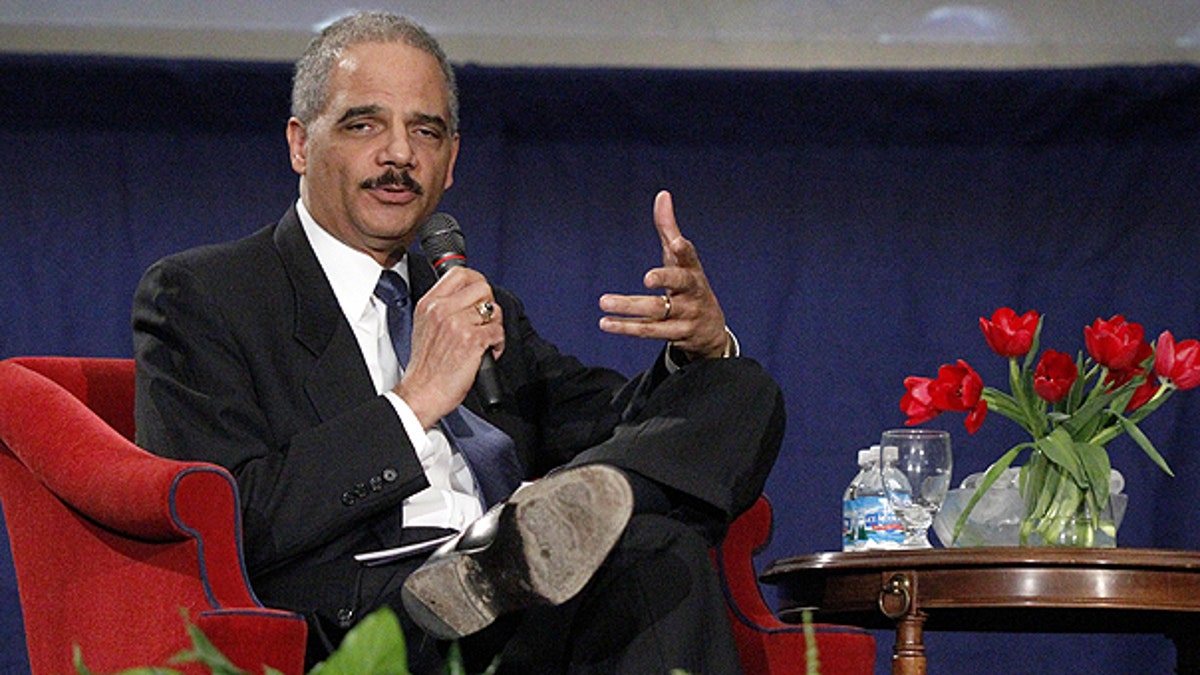
Feb. 23: Attorney General Eric Holder answers a student's question after his speech commemorating the 100th anniversary of the Duquesne University School of Law in Pittsburgh. (AP)
WASHINGTON -- Attorney General Eric Holder has asked a top Justice Department official to take another look at the efforts of U.S. agents who hunt gun traffickers along the U.S. border with Mexico.
Some in Congress have suggested the current strategy endangers law enforcement officers.
Holder's decision was followed Thursday by the U.S. Bureau of Alcohol, Tobacco, Firearms and Explosives announcing that it will ask a panel of law enforcement professionals to review the bureau's firearms trafficking strategies.
The ranking Republican on the Senate Judiciary Committee, Sen. Chuck Grassley, says he has been told by some personnel at ATF that the agency has allowed assault rifles to be sold to suspected straw purchasers for an illegal trafficking ring. Grassley questions whether agents adequately tracked the weapons after that.
Two of those weapons were recovered at a firefight that killed U.S. Customs and Border Protection agent Brian Terry last December.
The Justice Department turned down a request from Grassley for copies of communications between ATF headquarters in Washington and the agency's Phoenix office after Terry's death in southeastern Arizona.
"We are not in a position to disclose documents relating to any ongoing investigation," the Justice Department responded in a letter to Grassley.
In its statement, ATF said that the review will enable the bureau to maximize its effectiveness when undertaking complex firearms trafficking investigations and prosecutions.
"It will support the goals of ATF to stem the illegal flow of firearms to Mexico and combat firearms trafficking in the United States," the statement added.
The top Republican on the Senate Judiciary Committee, Sen. Chuck Grassley of Iowa, says he has been told by some personnel at the Bureau of Alcohol, Tobacco, Firearms and Explosives that the agency has allowed assault rifles to be sold to suspected straw purchasers for an illegal trafficking ring. Grassley questions whether agents adequately tracked the weapons after that.
Two of those weapons were recovered at a firefight that killed U.S. Customs and Border Protection agent Brian Terry last December.
CBS News reported Thursday that federal agents acknowledged allowing guns into Mexico as part of a Justice Department-approved plan by ATF to disrupt a drug cartel. Thousands of guns found their way south of the U.S. border because of the plan, and some of the guns began turning up at crime scenes in Mexico, according to the CBS report.
"We just knew it wasn't going to end well," John Dodson, a senior agent who was assigned to the ATF's Phoenix office in 2010, told the network. "There's just no way it could."
CBS reported that Dodson and other senior agents, who were not named, complained again and again to their supervisors about how the strategy appeared to have been contributing to the rising violence in Mexico. Dodson and other ATF sources took their concerns to Grassley's office, according to CBS.
The Justice Department turned down a request from Grassley for copies of communications between ATF headquarters in Washington and the agency's Phoenix office after Terry's death in southeastern Arizona, a border state.
"We are not in a position to disclose documents relating to any ongoing investigation," the Justice Department responded in a letter to Grassley.
The work of ATF on the border reflects the tension between conducting short-term operations aimed at arresting low-level straw buyers and long-term operations designed to move up the chain to identify criminal higher-ups directing the gun purchases.
In the letter to Grassley, dated Wednesday, Assistant Attorney General Ronald Weich said the IG's office has been asked by Holder to evaluate the concerns raised about ATF investigative actions and determine whether further investigation by the IG is needed.
In November, the IG's office concluded that a federal campaign to stop the smuggling of high-powered guns to Mexico is too narrowly focused on small-time gun runners and not the larger organizations suspected of arming Mexico's increasingly violent drug cartels.
The IG's report said that ATF agents working on Project Gunrunner have focused most of their efforts on one- and two-person cases at the behest of supervisors who urge them to close cases quickly and move on.
In a separate case not connected to Terry's death, authorities say a weapon purchased in October in the Dallas-Fort Worth area was used in a Feb. 15 attack on two U.S. Immigration and Customs Enforcement agents as they drove on a highway near San Luis Potosi in Mexico, killing Jaime Zapata and wounding Victor Avila. The man who bought the gun, his brother and a neighbor were part of a suspected gun-trafficking ring for a Mexican drug cartel. All three face federal weapons charges, none linked to Zapata's death.
That case developed after investigators for ATF and the Drug Enforcement Administration allegedly met a confidential informant near Dallas in November and gave him 40 guns to take into Mexico. The pistols, rifles and a shotgun -- most without serial numbers -- were seized before they crossed the border as part of the undercover operation by ATF and the Drug Enforcement Administration.
But authorities later learned that another gun purchased in October by one of the three men, Otilio Osorio, was used in the Feb. 15 attack that killed Zapata. It is unclear how, when and by whom that weapon was moved into Mexico.




